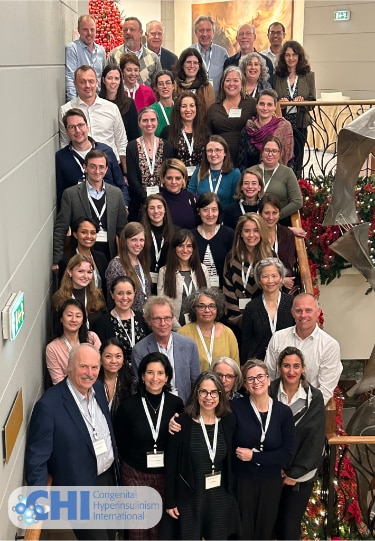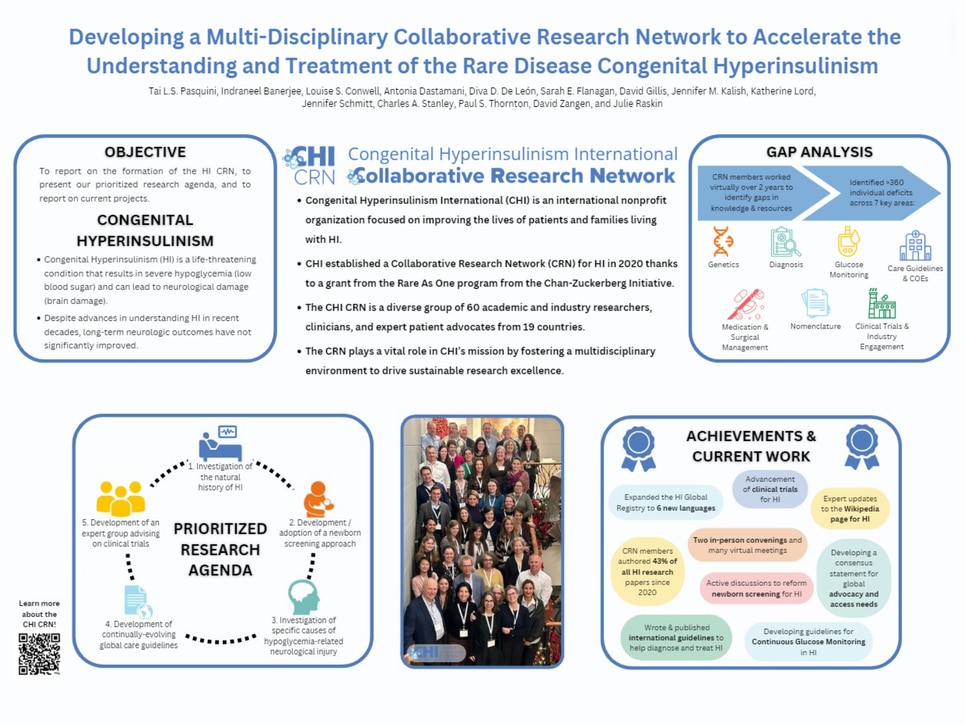
Overview
The CHI Collaborative Research Network (CRN) is a dynamic international collaboration of researchers, clinicians, and expert patient and caregiver advocates working together to accelerate hyperinsulinism research.
The CRN Mission is to create and sustain a hyperinsulinism collaborative research network that puts patients at the center of a strategy that leads to faster and more accurate diagnosis, drives new evidence-based treatments and cures, standardizes clinical guidelines, and facilitates increased and improved access.
History
The CHI CRN launched in December 2020 through a Chan Zuckerburg Initiative Rare as One (RAO) Network grant. The initial grant was awarded to 30 rare disease patient organizations, and mentorship, training, and peer support were provided to strengthen the organization and build the initial CRN network. CHI is still an active member of the growing RAO network.
During the first phase of the CRN, the focus was to identify a strategically prioritized roadmap for HI research, formulate a diverse funding strategy to launch the collaborative research agenda’s prioritized work, and establish an enduring foundation for sustaining the collaborative research network to achieve breakthroughs in timely diagnosis, better treatments, and cures for all types of HI with the ability to provide patient-level support to access care.
Members
The project relies on members of the CHI community bringing their perspective and expertise, including:
- patients/caregiver advocates who can inform research from the unique perspective of living with the disease and inspire physicians and scientists
- academic researchers who understand the scientific underpinnings of the disease and can help unlock unknown components of the disease
- clinicians who dedicate their lives to caring for patients
- industry researchers who investigate potential new treatments that can be brought to market

Learn more about the CHI CRN Members.
The CRN is led by the Core team:
- Lead Researcher: Diva D. De León-Crutchlow, Chief of the Division of Endocrinology and Diabetes and Director of the Congenital Hyperinsulinism Center at Children’s Hospital of Philadelphia
- Lead Clinician: Paul Thornton, Medical Director of the Congenital Hyperinsulinism Center, Endocrine and Diabetes Program at Cook Children’s Medical Center
- Patient Lead: Julie Raskin, Chief Executive Officer, Congenital Hyperinsulinism International
- CRN Administrator: Jennifer Schmitt, Chief Operating Officer, Congenital Hyperinsulinism International
- CRN Project Manager: Tai Pasquini, Chief Research Officer, Congenital Hyperinsulinism International
Prioritized Research Agenda
From 2021 to 2022, members of the CRN formed working groups called workstreams to
investigate key areas of HI. These groups worked together to identify research gaps and what work is necessary. During this time, the groups met 42 times and identified over 362 research and infrastructure gaps.
Workstream groups:
- Care Guidelines/ Centers of Excellence
- Glucose Monitoring
- Genetics
- Diagnostics
- Medical and Surgical Management
- What is HI? Nomenclature and Inclusion Criteria
- Clinical Trials/ Industry Engagement
After two years of identifying all the gaps, all workstream members came together in Lisbon, Portugal, in May 2022 to review and create an integrated prioritized research agenda for HI. CRN members engaged as one group for the first time with members from other workstreams to discuss their findings and finalize the research agenda.
Top 10 identified gaps in the prioritized research agenda:
| Workstream | Gap/Need |
| All | HI Natural History Study |
| Diagnostics | Identification and adoption of newborn screening approach |
| Diagnostics | Glucose as a vital sign |
| Medical and Surgical Treatments | Knowledge of the cause of neurological damage |
| Care Guidelines & Centers of Excellence | Continually evolving global care guidelines |
| Clinical Trials & Industry Engagement | An expert group to develop novel clinical trials and outcome measures for regulatory approval |
| Genetics | Access to genetic testing |
| Diagnostics | A biomarker for hyperinsulinism |
| Clinical Trials & Industry Engagement | Meaningful glycemic endpoints |
| Glucose Monitoring | Device technology for HI patients |
Current Work
Since May 2022, the CRN has been working in workgroups to tackle key items as identified in the prioritized research agenda.
- Newborn Screening (Diagnose all babies with congenital hyperinsulinism in a timely manner)
- Glucose as a Vital Sign (Increase awareness and timely diagnosis of HI)
- Care Guidelines (Create and disseminate continually evolving global care guidelines)
- Natural History (Build a robust registry that collects patient-reported, physician, and real-world data to provide a foundation for HI natural history)
- Continuous Glucose Monitoring (you can find the Guidelines on CGM Use in HI Patients here)
Each group has an array of short and long-term goals and objectives. The CRN is working on both easily obtainable and more long-range objectives. An example of an objective that was reached within a year is an expert consensus update for the congenital hyperinsulinism
Wikipedia page. This was made possible by working with a skilled Wikipedian and a committee
of experts The CRN is also building a foundation for much larger multi-year projects, such as a multi-center newborn screening protocol.
Other priorities are being addressed through the work of CHI and other CRN members.
CRN Successes
Since the launch of the CRN, the CRN members have published a total of 194 articles on
Congenital Hyperinsulinism in the areas of genetics, treatment and management, monitoring
and technology, screening and diagnostics, guidelines and education, patient experience and
quality of life, and policy and access.
One key publication was the first International Guidelines for the Diagnosis and Management of Hyperinsulinism. The CRN is working with the authors to create a lay version and to ensure that the guidelines are disseminated worldwide.
The formation of the CRN is already leading to new collaborations which are fundamental to progress. Convening this level of expertise has already resulted in additional collaboration, including an HI nurses working group, and an increased focus in the community for newborn screening and CGM use.
CRN Cornerstones
The HI CRN has a commitment to:
- supporting collaboration across the globe
- elevating the patient voice and ensuring the patient perspective is central to our work
- guaranteeing access to information, medical specialists, and treatments regardless of income and geography
- engaging new researchers and ideas to find innovative concepts and foster additional leaders in the HI network
- addressing diversity, equity, and inclusion in our work and our community
Supporting the CRN
The success of the CRN is dependent on a bold vision to think big, act globally, and make
meaningful progress to improve the lives of individuals in the HI community. Big goals require big support! The CRN is actively seeking grants, sponsorships, and donations for in-person meetings, multi-site research protocols, awareness campaigns, and supporting the
infrastructure to continue the collaboration. To learn more, please contact Julie Raskin at
jraskin@congenitalhi.org.


